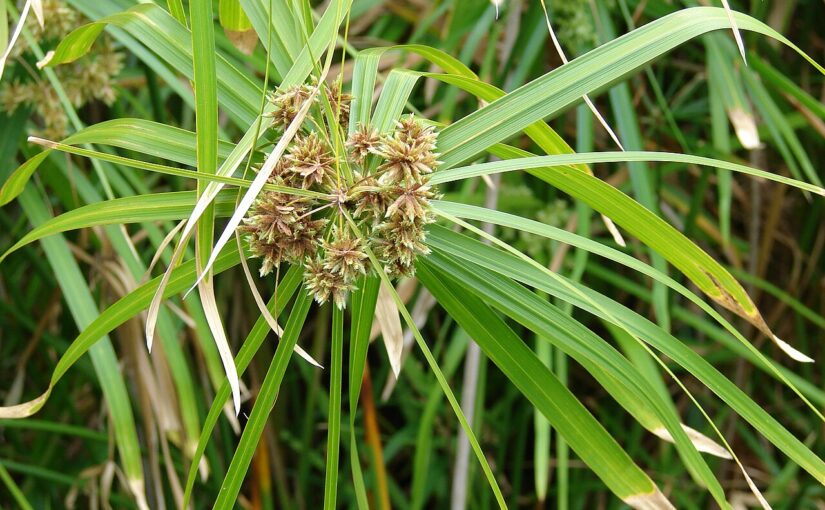Cypriol essential oil emerges from the resilient roots of a plant long cherished in ancient healing traditions. Known for its deep, grounding aroma, this oil draws from India’s wetlands and offers a bridge between body, mind, and spirit. In a world often filled with fleeting distractions, cypriol stands as a quiet reminder of rooted strength.
Botanical Profile
Cypriol, also called nut grass or nagarmotha, derives from Cyperus scariosus, a member of the Cyperaceae family. This hardy plant thrives in the tropical and temperate wetlands of Madhya Pradesh, India, though it adapts to climates worldwide. The essential oil comes from steam distillation of the rhizomatous roots, harvested between April and June when the plant’s energy peaks. India remains the primary producer, yielding a viscous oil in shades of light amber to brown.
The aroma is unmistakably earthy and spicy, with leathery, dry undertones reminiscent of vetiver and cinnamon. As a base note, it anchors blends with its persistent depth. Key constituents include cyperene, caryophyllene, copaene, longifolin, and longiverbenone, which contribute to its therapeutic potency.
Historical and Cultural Significance
Cypriol’s story is woven into the fabric of ancient medicine. In the Ayurvedic text Charaka-samhita, it is hailed as a powerful herb and perfume, valued for its ability to balance prana, or life force. Traditional Chinese Medicine similarly reveres its tenacious roots for regulating vital energy. Ancient healers turned to cypriol for fevers, digestive woes, and sacred rituals; its rich scent perfumed temples and ceremonial spaces.
Today, despite its reputation as an invasive weed in some regions, cypriol symbolizes resilience. Its grounding presence connects modern aromatherapy to these timeless practices, offering depth and stability in an era of rapid change.
Therapeutic Benefits
Cypriol essential oil delivers a robust array of healing properties, rooted in its sesquiterpene-rich composition. For digestive health, it acts as a carminative, easing nausea, diarrhea, stomach cramps, and colitis while gently supporting appetite. Those battling inflammation find relief in its analgesic effects, which soothe arthritis, fibromyalgia, rheumatism, and menstrual pain.
As a diuretic and tonic, cypriol helps reduce edema, manage gout, and prevent kidney stones, all while aiding the body’s natural detoxification. Its emmenagogic qualities balance hormones, relieve menstrual cramps, and regulate irregular cycles. The oil also serves as a febrifuge and sudorific, lowering fevers through induced sweating.
Nervine actions calm stress, anxiety, and high blood pressure, promoting overall tranquility. In skin care, cypriol treats acne, dry skin, rashes, and scabies with its purifying touch. Additionally, it functions as an anthelmintic to expel parasites and a hemostatic to control minor bleeding. Cyperene leads the charge in these anti-inflammatory and grounding benefits, making cypriol a go-to for pain management, skin vitality, and emotional equilibrium.
Aromatherapy Uses
Incorporating cypriol into daily routines is straightforward and rewarding. For diffusion, five drops in one hundred milliliters of water creates a serene space for stress relief or meditation; blending with frankincense adds layers of spiritual depth. Topical application calls for fifteen drops in one ounce (thirty milliliters) of coconut oil, ideal for massaging into joints for pain relief, cramps, or troubled skin.
A warm bath infused with ten drops of cypriol (mixed with a dispersant) soothes the body, offering relief from fibromyalgia or general skin irritation. For quick calm, inhale one or two drops from a tissue to ease nerves or clear congestion. Due to its strong aroma, use cypriol sparingly in diffusers, and always dilute properly for skin contact to ensure comfort.
Emotional and Energetic Effects
The leathery, earthy scent of cypriol is profoundly grounding. It anchors the spirit amid chaos, easing stress and fostering emotional stability with a quiet, reassuring presence. This oil reconnects users to their inner strength, much like its role in regulating prana, and ties closely to the root chakra. With yin energy and the earth element at its core, cypriol excels in meditation, helping to heal feelings of disconnection.
Imagine it as a deep hum from India’s riverbanks, steadying the soul and inviting resilience. It addresses stress, anxiety, disconnection, and emotional instability, encouraging a return to centered living.
Blending and Companion Oils
Cypriol blends seamlessly with oils that enhance its earthy profile. It pairs beautifully with bergamot, cedarwood, clary sage, frankincense, geranium, labdanum, myrrh, patchouli, sandalwood, and vetiver. These combinations amplify grounding and balancing effects. For substitutes, vetiver, patchouli, or sandalwood provide similar anchoring qualities, though they lack cypriol’s distinctive spicy edge.
Safety and Precautions
Cypriol essential oil is generally well-tolerated, but precautions matter. Avoid it during pregnancy due to its emmenagogic properties; always consult a healthcare provider first. Skin irritation is rare yet possible, so dilute to one or two percent (six to twelve drops per one ounce carrier oil) and perform a patch test. Use cautiously with children, seeking professional advice.
Store cypriol in a dark glass bottle in a cool, sealed environment, where it maintains potency for four to six years. Reserve it for external use only, avoiding ingestion without expert guidance.
Cypriol’s Earthy Embrace
Picture cypriol oil as a deep hum from India’s riverbanks. Its spicy, earthy aroma grounds the soul and eases pain. Once a sacred Ayurvedic elixir, it now soothes inflammation, balances hormones, and anchors emotions. Whether diffused for peace or massaged for relief, cypriol beckons users to embrace its rooted resilience, drawn from the ancient threads of the Charaka-samhita.
Cypriol essential oil, with its leathery scent, is a potent remedy from India’s wetlands. From supporting digestion and pain relief to providing emotional grounding, it serves as a versatile ally. Carrying the enduring legacy of nagarmotha, every amber drop invites a return to balance and depth in wellness practices.
Image: Forest & Kim Starr.
